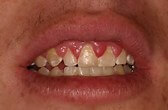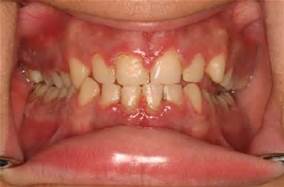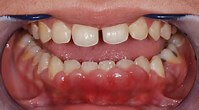As a gum specialist, we often see and help treat changes in patient’s gum tissues related to certain medications they are taking. One of the main issues we come across is gingival overgrowth, or hyperplasia.
Gingival hyperplasia is an overgrowth of the gum tissue around your teeth. In our practice, we sometimes see that certain medications our patients are taking contribute to gingival hyperplasia. Other factors can include orthodontic treatment or certain medical issues, such as hormonal imbalances, leukemia, a genetic condition or the growth can sometimes be due to a benign or malignant lesion. Inflammation of the gums and poor plaque control are often a main contributor for gum overgrowth. Poor oral hygiene also can increase inflammation which may also play a role.
Medications associated with gum enlargement fall into three main categories:
- Anti-seizure medications
- Immunosuppressant medications (used in transplant patients),
- Calcium channel blockers used to treat certain heart conditions, most commonly high blood pressure.
It is important to notify your dentist or dental hygienist if you take any of these medications so they can watch for changes in your gum tissues. Many of our patients are on some form of calcium channel blocker such as Amlodopine (Norvasc) or Diltiazem for high blood pressure.
A more severe case of gingival overgrowth could effect a person’s appearance when they smile or talk. Enlarged gum tissue will complicate and sometimes completely prevent patients from being able to remove harmful plaque bacteria at and below the gum line and in between their teeth. The tissues become enlarged, grow over the surface of the teeth and can become fibrotic, or tough. Once overgrowth has started, it becomes more difficult to maintain good oral hygiene. This will lead to retaining more damaging periodontal bacteria under the gum line, which can in turn worsen the gingival hyperplasia.
If a big factor of the gum overgrowth is a medication, your physician may need to be consulted. Stopping or changing the medication can help limit the overgrowth, but do NOT stop the medication on your own. Your dentist or periodontist can communicate with your medical doctor to see if your medication can be altered. In some cases, a person’s medical professional will advise against altering a medication, most often in seizure disorders, immunosuppressed patients, and certain heart conditions or difficult to manage blood pressure. If this is the case, we have to handle the gingival overgrowth as best we can. Options include increased oral hygiene, non-surgical, or surgical periodontal therapy.
Even if the medication causing this condition can be altered or discontinued, this will not necessarily reverse the overgrowth. Additional treatment is sometimes required and often includes:
AT-HOME CARE Good oral hygiene, especially the effective removal of plaque between the teeth and at the gum line, can alleviate the condition in early or very mild cases.
NON-SURGICAL THERAPY
In a mild to slightly moderate condition, a series of scaling and root planing procedures (commonly known as a “deep cleaning”) can be performed, often by a dental hygienist using local anesthesia.
Your dentist or periodontist may have you return every three months for dental hygiene visits to limit the effects of inflammation on the soft tissues.
SURGICAL REMOVAL
In severe cases, the enlarged or hyperplastic gum tissue may need to be removed surgically. In the case of drug-induced overgrowths, if patients are not able to discontinue the medication, surgical removal may be the only effective treatment. This can be done with a scalpel or laser.
If you think you have an area of overgrowth, visit your dentist for an evaluation of your condition. If you are now taking medications that can cause gingival overgrowth, consult with your dental professional and physician. If you have questions about gingival hyperplasia you can contact us at 727-586-2681 or https://brittenperio.com








